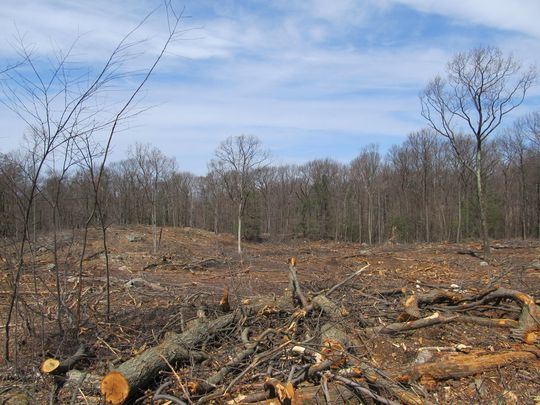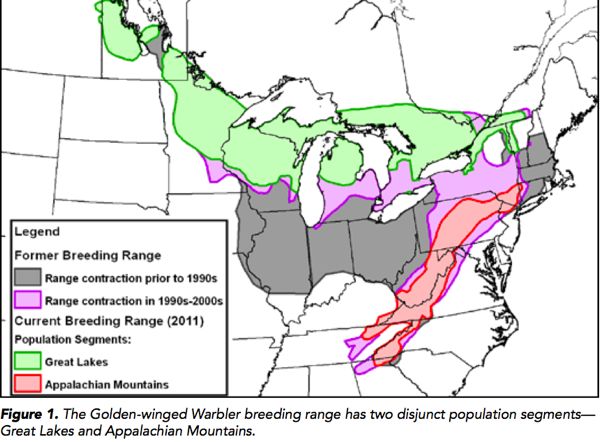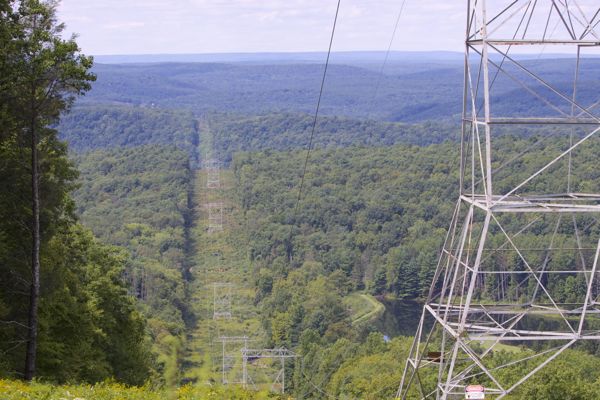DEP’s Sparta Mountain Logging Scheme Conflicts With Golden Wing Warbler Recovery Plan It Allegedly Is Based On
Foresters suddenly express interest in protecting habitat & golden wing warbler
DEP Plan Seeks To “Mimic” & “Purposefully Create” Utility ROW Conditions
Plan Calls For Herbicide Treatments In Public Water Supply Watersheds
Destroying a Forest To Save It
This is what “stewardship” looks like – a clearcut, no?

A first harvest is completed in April 2012 in this section of the Sparta Mountain Wildlife Management Area during a forest restoration project. (Photo: PHOTO COURTESY OF DON DONNELLY)
[Intro note: I don’t pretend to be a birder or a botanist, so urge readers with expertise to jump in and comment where I got it wrong or failed to include nuance or important issues.]
The DEP’s proposed logging plan for Sparta Mountain is designed primarily to promote recovery of golden wing warbler (GWW). The DEP plan is based on an Appalachian regional GWW recovery plan.
The DEP Sparta Mountain plan states:
The following recommendations are meant to broadly describe target treatments using GWWA as an umbrella species for ESH creation. Actual implementation will follow the guidelines set forth by the GWWA Working Group – Best Management Practices for GWWA in the Appalachian Region 2013. (page 29).
But after reading the “guidelines set forth by the GWWA Working Group”, it is clear that the DEP Sparta Mountain logging plan contradicts those guidelines.
Conflicts with the Appalachian regional GWW recovery plan
The Appalachian Regional GWW recovery plan explicitly recognizes that there may be competing conservation objectives. The Appalachian Plan describes two specific types of locations where the GWW recovery BMP’s are NOT appropriate or recommended and affirmatively “should be avoided“:
When possible, avoid places where other rare or imperiled resources are higher priority and have conflicting needs, and where Blue-winged Warbler co-occurs and management for Golden-winged Warbler might hasten Blue-winged Warbler invasion, increasing the probability for hybridization. ~~~ Golden-winged Warbler (GWWA) Working Group. Best Management Practices for GWWA in the Appalachian Region. 2013
Repeat: The Appalachian Regional GWW recovery plan recommends that managers avoid “places where other rare or imperiled resources are higher priority and have conflicting needs”.
In our prior Part One post, based on the US Forest Service Report and the NJ Highlands Act, we identified several “higher priority conflicting needs” that must be considered, including water resources, forest ecology, habitat conservation, and recreational values. Specifically:
1) large blocks of intact Highlands forests with full canopy cover are rare and imperiled;
2) high quality NJ water resources and pristine potable public water supplies are rare and imperiled;
3) interior neo-tropical migratory birds and their habitats are rare and imperiled;
4) opportunities for outdoor passive recreation are rare and imperiled; and
5) the capacity to sequester carbon to mitigate climate change is rare and imperiled.
All of these higher priority needs that conflict with the DEP’s proposed logging plan.
The Appalachian Regional GWW recovery plan also explicitly recognizes the risks and problems related to hybridization with Blue winged warbler (BWW) and recommends that those places be “avoided”.
Yet the DEP’s Sparta Mountain logging plan precisely documents the same BWW risks and places that should be “avoided”. The DEP plan states:
Another problem for GWWA has been invasion of its habitat by the closely related Blue-winged Warbler (BWWA). BWWA populations have expanded as historic GWWA shrub-scrub habitats have succeeded into young forest. GWWA and BWWA hybridize readily, and BWWA can often out-compete GWWA to claim nesting sites on marginal GWWA habitat. (@ page 28)
Therefore, the Appalachian Regional GWW Recovery Plan specifically recommends AVOIDANCE on places like Sparta Mountain, where competing objectives and risks of hybridization with BWW exist.
These conflicts alone should be sufficient grounds to reject the DEP’s proposed plan.
The numbers don’t work – NJ too small a fraction of GWW habitat range
But in addition to this basic conflict between the Appalachian Regional Plan upon which the DEP’s Sparta Mountain Plan is allegedly based, the data in the Appalachian plan show that, even if the Sparta Mountain plan were to succeed, the GWW benefits would be tiny.
The DEP Sparta Mountain logging plan applies to about 3,400 acres – the GWW range is 2,070,000 acres. The Sparta Mt. logging would amount to less than 0.2 percent of the total GWW range.
The benefits to GWW would be so small, that they could not possibly justify the negative water resource, ecological, conservation, and recreational values of logging Sparta Mountain
Specifically, the Appalachian Plan sets two basic short and intermediate term goals: increase habitat and populations (see Table 1 below):
The 2020 Appalachian regional population goal is to increase the population by 5,000 birds, from a 2010 population of 22,000 to 27,000.
According to DEP, there are only 25 breeding pairs of GWW in the entire State – an estimate not even mentioned in the DEP’s plan. (Morris Daily Record story):
The primary goal was to maintain a forest ecosystem that would attract golden-winged warblers. These 4.8-inch songbirds, adorned with splashes of bright yellow plumage, are listed as an endangered species in New Jersey, with only about 25 breeding pairs remaining in the state.
“In the late 90s, there were about 100 pairs recorded,” said John Cecil, vice president for stewardship with New Jersey Audubon. “So, that should give you a sense of how dramatic the decline has been.”
NJ’s GWW population (25 breeding pairs, 50 birds) is less than 0.02% of the estimated total 2010 population of 414,000.
Even if NJ’s statewide GWW population were all located on Sparta Mountain and restored to 1990 levels by 2020 (which is not technically possible), that would only contribute 4% to the regional GWW increase goal.
Does that highly uncertain and very small positive contribution justify all the very likely significant negative impacts of logging over 3,000 acres of intact forest in the Highlands Preservation area? I don’t think so.
Similarly, NJ forest comprise a minuscule fraction of the GWW Appalachian range – take a look at the map from the Appalachian regional GWW recovery plan:
The habits goal is an increase of 27,000 acres by 2020. Sparta Mountain logging would create an insignificant contribution toward that goal that clearly would not justify adverse impacts of the logging.
Climate change changes everything – including habitat range
In addition to Sparta Mountain’s ability to provide de minimus benefits to GWW population and habitat acreage goals, there is scientific evidence that suggests that GWW habitat will no longer even be present in NJ as a result of global warming.
Here’s a key factor that National Audubon Society identifies See:Global Warming and birds:
Global warming is the greatest threat to birds and other wildlife in human history. The rate of global warming is already impacting birds, their prey, and their habitat. Those impacts will become more severe over the coming decades, leading to the loss of one-quarter to one-third of all species on earth, including many bird species. […]
Is Global Warming Already Affecting Birds?
Scientists are already seeing alarming impacts of global warming on birds. More than 80% of plant and animal species studied have shown changes in the timing of migration or reproduction, shifts in habitat or migratory routes, or other changes associated with climate change. Some of the observed impacts on birds include:
• Several North American warbler species have shifted northward more than 65 miles. The Golden-winged Warbler’s range has moved nearly 100 miles north just in the past two decades.
No herbicides in public potable water supply watersheds
On top of all these fatal flaws, the DEP plan also relies on extensive herbicide treatments.
Here is the Appalachian Plan’s promotion of that:
Herbicide Application: Apply herbicides that selectively target woody plant growth, especially in combination with other management tools such as fire, grazing, or mowing to retard plant succession and prolong the period of habitat suitability. (page 6)
And here is the DEP’s Sparta Mountain’s plan with respect to herbicide use:
- Pesticides are not proposed to be used in this FSP, but select herbicides may be used as needed. No broadcast herbicide application will be done within 100 feet of wetlands, vernal pools, or ephemeral ponds. (page 22)
A perverse aspect of the DEP plan with respect to herbicide use is that logging will increase sunlight hitting the forest floor. It is well known that increasing sunlight on the forest floor promotes explosive growth of invasive species.
So, after creating the conditions to cause huge proliferation of invasive species, the DEP plan calls for more herbicides to kill them:!
Before implementing management proposed in this plan, invasive species populations will be evaluated at project sites, and when more than five percent of the vegetation consists of invasive plants, the site will be pre-treated with mechanical or herbicide applications deemed most appropriate for the species in question. (page 32)
It is ludicrous to promote the use of toxic herbicides in the forests that protect the Highlands water supply for millions of NJ residents.
And herbicides have a negative impacts on ecosystems, including the GWW.
Twisted perverse logic – Killing the forest to save it
Finally, I close with stating a completely bizarre stated justification for the DEP’s logging plan.
In essence, it’s kind of like the absurdity of the Vietnam war military logic in the town of Ben Tre: “We need to destroy a village to save it”.
According to the DEP plan, we need to create utility line ROW conditions in mature intact forests.
Seriously. The DEP Plan notes that GWW previously benefitted from utility ROW, but now that same ROW is being eliminated by new federal rules mandating more aggressive ROW clearance. So therefore, more ROW like habitat needs to be “purposefully created” by logging mature forests:
Utility ROWs have offset some habitat loss in the past, as vegetation maintenance intervals were typically very irregular, sometimes extended upwards of 20+ years between re-entry. This allowed for natural succession and woody stem development to occur. However, recent regulatory changes accompanied by stiff fines for non-compliance have made power companies more aggressive about preventing woody vegetation development within easements. This increasingly reduces habitat availability for GWWA and other ESH dependent species. If we are to stabilize or restore ESH dependent wildlife populations, we need to have ESH on the landscape at a sustainable level, and if that no longer occurs naturally (due to anthropogenic influences discussed earlier), then we need to purposefully create it. (page 28-29)
The DEP plan relies on this same absurd logic on ROW conditions with respect to rare plants – remarkably, the DEP plan calls on “mimicking ROW”:
Instead of leaving their existence to the fate of the utility companies, we can manage areas outside of the ROWs near existing source populations to become reservoirs for these plants by mimicking conditions on the ROW. (page 27)
In Part three, we will look at how logging is exempt from environmental regulations, including all local land use regulations, Highlands Act restrictions, steep slopes, vernal pond, wetlands, stream & lake buffers, and soil erosion requirements.
[Absurd Endnote: Meanwhile, Pennsylvania and Appalachian forests are being decimated by fracking and mountaintop removal coal mining, without a peep from all the GWW fans.
Or is that destruction beneficial, because it creates more early successional forest habitat like utility ROW’s?


